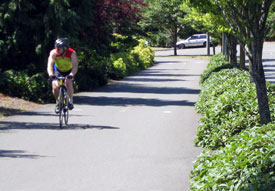Published March 13 2015
The City of Bellevue is a step closer to making pedestrians and bicyclists count more here, after installing automatic count systems on multi-use trails by Interstate 90 and State Route 520 this month.
The Washington State Department of Transportation and the city installed the count systems as part of a pilot project to assess various count technologies for non-motorized travel.
For the first time, Bellevue has a system that will count pedestrians and bicyclists accurately and efficiently through a detection sensor and data logging software. This advances Bellevue from manual count collection typically done by volunteers twice a year to a system counting 24 hours a day.
"We are pleased to be selected to participate in the state's pilot study," said Dave Berg, the city's Transportation Director. "This study aligns with Bellevue's Pedestrian and Bicycle Implementation Initiative, which promotes an accessible, well-connected network that enhances livability, supports economic vitality and serves the mobility needs of people of all ages and abilities. I think the data is essential to building a more complete and reliable citywide baseline for non-motorized travel patterns."
The count system for the SR-520 location tracks the direction pedestrians and cyclists are going, and cost $4,500. The system for I-90 only counts pedestrians and cyclists, not recording their direction of travel. It cost $3,900. WSDOT paid for both systems. This project leverages emerging technologies (inductive loops and infrared systems) to gather and analyze data.
Bellevue's Comprehensive Plan instructs city staff to develop procedures to monitor pedestrian and bicycle usage on an ongoing basis. The data collected through this project will help track Bellevue's progress toward its goal of improving bicycling and walking conditions in the city.
The information also contributes to a larger effort statewide to improve decisions about where to invest transportation funds and how to improve safety. Data from these counts will be used to inform investments in bicycle and pedestrian facilities as well as educational programs statewide.
The pilot study will help Bellevue and WSDOT answer many question about when and where pedestrians and bicyclists walk or ride in Bellevue.
"This is a tremendous investment and an excellent tool to help us make smart decisions in the future," Berg said. "It will definitely help us plan and justify investments, help us understand usage patterns and help evaluate long-term trends for Bellevue's future. I'm looking forward to continuing this partnership with WSDOT."

